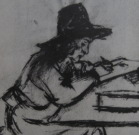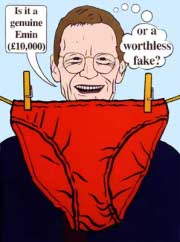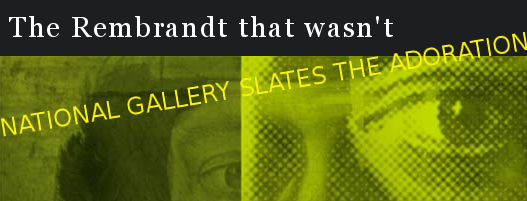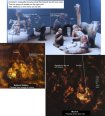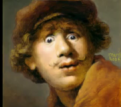| Fake Titus Drawing Loved by 'Experts' |
|
Click to download or view the movie on your player:
Recent video showing Fake drawing of Titus so loved by the Experts (Takes only 2 minutes to watch) by Nigel Konstam I have registered my plea not to reappoint Sir Nicholas Serota as director of the Tate Gallery after 21 years in the job! You will find it on YouTube. I feel it is necessary to make a similar declaration about art historians dealing with ancient art. Having scored a million hits with this site in the last 3 years I find it strange that I have received no feedback, questions or requests for the DVD from Rembrandt scholars, not one. They are clearly determined to go on as they have done: destroying Rembrandt as they go. Some stronger medicine is required. I have chosen to start with Professors Slive and Benesch because as past professors of Harvard they are clearly out of the top draw . They represent the best art history can produce. See the video - (Same as above) The education of the art historians ill fits them for the job we expect of them. Inadvertently they have nearly destroyed Rembrandt, “one of the greatest artists of all time..... unmatched range,depth and human sympathy” (writes Prof.S.Slive). I do not exaggerate, in my life-time Rembrandt has dropped from number one among artists to a position where he does not even appear in the list of the top 30. Over half his paintings and drawings have been de attributed for no good reason and his stock as a human being to be trusted, if not revered, has dropped like a stone. As a result of the scholars efforts The Wall Street Journal had this to say about him. “ Rembrandt van Rhijne was a money changer in the temple of art, he bought and sold..... After The Burlington Magazine (Feb 1977)published my article . I was invited to lecture at Harvard (at my own expense) where the whole faculty was more or less devoted to Rembrandt and his school . I told them then what I had written and a bit more. The lecture was not well received as you can imagine. After an initial burst of fury it was quickly forgotten. Though there must have been 30 doctoral students present I have heard nothing from any of them since. I have been treated as a pariah by Rembrandt scholars. The RRP. twice refused my offer to come and speak to them in Amsterdam. I have run a Save Rembrandt (from the experts) Campaign, and published 3 campaign newspapers . My book on Rembrandt has circulated among 30 publishers without finding one brave enough to publish it. Phaidon first accepted and then refused after receiving a vile reader's report. I have continued to lecture whenever possible. (Once I was even paid to do so.) Please bare this history in mind if you find me uncharitable towards art historians. I see what I see as the result of training as a sculptor in the old school. The art historians do not see what the rest of us see as the result of their training - in the not so new school of Wolfflin. In the 35 years since I made my discovery of Rembrandt's use of models and mirror the establishment have done everything in their power to stop the circulation of this new knowledge. Many examples of how this is done can be found in the British Museum's Catalogue of Remberandt's drawings. A whole team of experts is lined up to deny the obvious truth in what I say. From their behaviour over the last 35 years I think it highly unlikely that they will ever find the will to reform themselves. Reform must be forced upon them, or better still artists should reclaim their lost initiative as historians of art. They will make a much better job of it than our art historians; simply because they know what they are talking about. But this must happen soon before all traces of art as it was has disappeared. When I was a student at Camberwell (1956) we students made it our business to see all the great sculpture we could. It was not a compulsory chore as now, when taught by art historians. It was considered a necessity. We needed to see where we had come from, in order to know where we wanted to go. We saw ourselves as a part of a great tradition to which we hoped to make some contribution. By now people have forgotten that this attitude was the norm for the past 40,000 years; the norms have changed that much. We were not straining to create some novelty as every student must today. Pathetic novelties are haled as the cutting edge of evolution but alas, genuine evolution is not that easy, it happens rather rarely. Our culture can no longer distinguish good from bad thanks to the misguidance of art history (see video). So we have to content ourselves with what is new (and usually trite). PARADIGM SHIFTSWe speak of paradigm shifts as if they were as easy to accomplish as a gear change but for an establishment scholar faced with the paradigm shifts required to come to a sensible understanding of Rembrandt they are closer to an earthquake. No Rembrandt scholar is going to voluntarily subject themselves and their colleagues lives to such a catastrophe. If they did they would be left without a highly prestigious field of expertise with very little hope of recovering it within a life-time because their training has misdirected their vision. They cannot see the wood for the trees. I am addressing myself to the up and coming generation who must surely see that it would be madness to study Rembrandt under the old regime; it is far to full of holes. The refusal of the establishment to enter into discussion is indication enough of the weakness of their case. To follow that weaknesses see “The Mirrors” section for their absurdly impractical and fictitious theory of Rembrandt's development as a draughtsman - for the mistaken idea that Rembrandt, the great master of imagination was capable of drawing from his inner vision “as if he had seen them (the biblical scenes) in reality” see the section on “Imagination” - for the mistaken idea that masters can achieve their dreams directly without going through the usual process of trial and error, and in Rembrandt's case, observation - see “Job”. These three fundamental errors have gravely distorted our image of Rembrandt who is by far the most important landmark in the evolution of our vision of the human condition. Are we really prepared to put up with this state of affairs to save a very few experts from discomfort? They have undermined Rembrandt's life's work, they have shuffled in a number of minor students to fill the gaps they have created, they have stood his artistic philosophy on its head and cast aspersions on his character. A final complaint against the experts has to be mentioned, as far as the drawings are concerned - their connoisseurship is deplorable. How could they have overlooked such masterpieces as The Deathbed of David or Isaac (refusing to bless Esau) for 80 years? |


